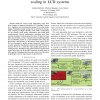Free Online Productivity Tools
i2Speak
i2Symbol
i2OCR
iTex2Img
iWeb2Print
iWeb2Shot
i2Type
iPdf2Split
iPdf2Merge
i2Bopomofo
i2Arabic
i2Style
i2Image
i2PDF
iLatex2Rtf
Sci2ools
DATE
2009
IEEE
2009
IEEE
Visual quality analysis for dynamic backlight scaling in LCD systems
—With the trend toward high-quality large form factor displays on high-end handhelds, LCD backlight accounts for a significant and increasing percentage of the total energy budget. Substantial energy savings can be achieved by dynamically adapting backlight intensity levels while compensating for the ensuing visual quality degradation with image pixel transformations. Several compensation techniques have been recently developed to this purpose, but none of them has been fully characterized in terms of quality losses considering jointly the non-idealities present in a real embedded video chain and the peculiar characteristics of the human visual system (HVS). We have developed a quality analysis framework based on an accurate embedded visualization system model and HVS-aware metrics. We use it to assess the visual quality performance of existing dynamic backlight scaling (DBS) solutions. Experimental results show that none of the DBS techniques available today is fully capable of kee...
| Added | 20 May 2010 |
| Updated | 20 May 2010 |
| Type | Conference |
| Year | 2009 |
| Where | DATE |
| Authors | Andrea Bartolini, Martino Ruggiero, Luca Benini |
Comments (0)

